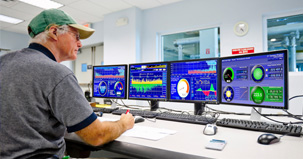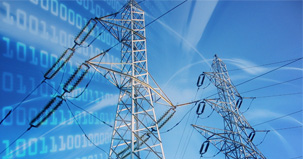- Home
- Smart Data
Smart Data
Actionable intelligence on energy and water use:
- Helps users identify inefficencies, and waste
- Provides real-time feedback on conservation
Right data for the right audience:
- Facility managers identify when and where energy is wasted
- CFO's can track and verify financial savings from initiatives
- Company knows its carbon and water footprint
Related Products
 Information any time, anywhere
Information any time, anywhere - Smart User
Smart User
Smart users leverage real-time data and reduce energy and water use by:
- Continuously identifying opportunities
- Acting on opportunities
- Tracking and verifying savings
- Sustaining savings
Related Products
 Monitor, Manage, Maintain
Monitor, Manage, Maintain - Smart Community
Smart Community
A smart community is one where all stakeholders are engaged in energy and water conservation. A smart community can be achieved by:
- Showing people precisely how much they are using
- Providing real-time feedback on conservation actions
- Effectively communicating efficiency results
Related Products
 Communicate and Conserve
Communicate and Conserve - Smart Grid
Smart Grid
Smart grid, as we define it, is a "green grid", with efficient resource use and the key to a low-carbon future. We help our customers prepare for the smart grid by:
- Engaging users with smart data
- Enabling smart users to increase resource efficiency
- Educating & empowering smart communities
Related Products
 Smart grid and a smarter future
Smart grid and a smarter future - Smart Buildings
Smart Buildings
Smart buildings maximize resource (energy, water, capital) efficiency. These buildings are optimized using energy and water management process with high data visibility which lead to reduced energy and water spending.
- Higher operating income and higher asset values for owners
- Increased productivity for occupants
- Lower carbon footprint for the community
 Resource efficient buildings
Resource efficient buildings
Subtitle!
Recent Posts
Obama's Better Building Initiative - What's It Going to Take?
The Obama administration announced the Better Buildings Initiative in February 2011, the goal being a 20 percent improvement in energy efficiency by 2020.
If this exciting, yet perhaps lofty, goal is achieved, the country’s collective corporate energy bills would decrease by approximately $40 billion. Specifically, the president pointed to CEOs and university presidents throughout the country, maintaining that large companies and post-secondary institutions should be leaders in efficiency.
There are several facets to this initiative, including more favorable tax deductions for those who comply. In announcing this program, President Obama focuses on existing structures and the need for widespread retrofitting initiatives. And, he is willing to back up his suggestions with important – and much-needed -- dollars.
For example, a proposed U.S. Department of Energy pilot would guarantee loans that are going toward efficiency-oriented improvements to hospitals, schools, and commercial buildings. As funding is often a barrier in retrofitting, this is a welcome opportunity for many. Additionally, state governments that make it easier for the private sector to adopt green standards will be given grants. Any state government that makes concessions in order to attract private sector investment will be awarded through the initiative.
In keeping with the plan’s view toward the future, part of the Better Buildings Initiative is to train the younger workforce in energy auditing practices, as well as building operations. By making this a priority, the U.S. can ensure that energy conservative practices will be developed for generations to come. More transparency around energy efficiency in the workforce is one of the major goals of this plan.
In the announcement of this initiative, President Obama emphasized the idea of innovation. New technologies are needed to help ensure that his administration’s ambitious energy goals are met.
Luckily, certain companies have taken the lead in this department. For example, Noveda Technologies, a company headquartered in Branchburg, N.J. offers cost-effective, easier-to-use technologies that allow companies to monitor and reduce their energy and water usage.
Noveda’s EnergyFlow Monitor tracks your building’s energy (electricity, gas, steam, oil) & water use in real-time and at the most granular level. The EPA estimates that as much as 30 percent of energy used in buildings is either wasted or inefficiently used. EnergyFlow Monitor enables customers to uncover the source of energy waste and gauge the impact of actions taken to eliminate waste. By using real-time monitoring tools such as the EnergyFlow Monitor, companies are able to fine-tune their energy and water usage practices, and get nearer to achieving the numbers laid out by the Obama government’s proposal.
The Better Buildings Initiative has started a search for clean energy, and for methods of conservative energy use. New building methods must be employed, and energy must be closely monitored. Only in this way will we be able to meet the initiative’s ambitious goals, and put ourselves on the path to healthier building practices.
Originally posted in Renewable Energy World.com